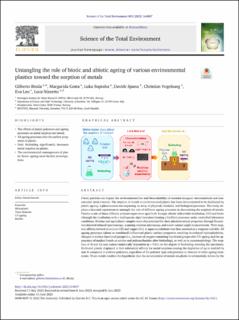| dc.contributor.author | Binda, Gilberto | |
| dc.contributor.author | Costa, Ana Margarida Pinto E. | |
| dc.contributor.author | Supraha, Luka | |
| dc.contributor.author | Spanu, Davide | |
| dc.contributor.author | Vogelsang, Christian | |
| dc.contributor.author | Leu, Eva | |
| dc.contributor.author | Nizzetto, Luca | |
| dc.date.accessioned | 2023-09-21T14:25:58Z | |
| dc.date.available | 2023-09-21T14:25:58Z | |
| dc.date.created | 2023-08-18T08:30:19Z | |
| dc.date.issued | 2023 | |
| dc.identifier.citation | Science of the Total Environment. 2023, 893, 164807. | en_US |
| dc.identifier.issn | 0048-9697 | |
| dc.identifier.uri | https://hdl.handle.net/11250/3091148 | |
| dc.description.abstract | Plastic particles can impact the environmental fate and bioavailability of essential inorganic micronutrients and non-essential (toxic) metals. The sorption of metals to environmental plastic has been demonstrated to be facilitated by plastic ageing, a phenomenon encompassing an array of physical, chemical, and biological processes. This study deploys a factorial experiment to untangle the role of different ageing processes in determining the sorption of metals. Plastics made of three different polymer types were aged both through abiotic (ultraviolet irradiation, UV) and biotic (through the incubation with a multispecies algal inoculum forming a biofilm) processes under controlled laboratory conditions. Pristine and aged plastic samples were characterized for their physiochemical properties through Fourier-transformed infrared spectroscopy, scanning electron microscopy and water contact angle measurements. Their sorption affinity toward aluminum (Al) and copper (Cu) in aqueous solutions was then assessed as a response variable. All ageing processes (alone or combined) influenced plastic surface properties resulting in reduced hydrophobicity, changes in surface functional groups (i.e., increase of oxygen containing functional groups after UV ageing and the appearance of marked bands as amides and polysaccharides after biofouling), as well as in nanomorphology. The sorption of Al and Cu was instead statistically dependent (p < 0.01) on the degree of biofouling covering the specimens. Biofouled plastic displayed in fact substantial affinity for metal sorption causing the depletion of up to tenfold Cu and Al compared to pristine polymers, regardless of the polymer type and presence or absence of other ageing treatments. These results confirm the hypothesis that the accumulation of metals on plastic is substantially driven by the biofilm present on environmental plastics. These findings also highlight the importance of investigating the implications of environmental plastic for metal and inorganic nutrients availability in environments impacted by this pollution. | en_US |
| dc.language.iso | eng | en_US |
| dc.publisher | Elsevier | en_US |
| dc.rights | Navngivelse 4.0 Internasjonal | * |
| dc.rights.uri | http://creativecommons.org/licenses/by/4.0/deed.no | * |
| dc.title | Untangling the role of biotic and abiotic ageing of various environmental plastics toward the sorption of metals | en_US |
| dc.type | Peer reviewed | en_US |
| dc.type | Journal article | en_US |
| dc.description.version | publishedVersion | en_US |
| dc.rights.holder | © 2023 The Authors | en_US |
| dc.source.pagenumber | 12 | en_US |
| dc.source.volume | 893 | en_US |
| dc.source.journal | Science of the Total Environment | en_US |
| dc.identifier.doi | 10.1016/j.scitotenv.2023.164807 | |
| dc.identifier.cristin | 2167810 | |
| dc.source.articlenumber | 164807 | en_US |
| cristin.ispublished | true | |
| cristin.fulltext | original | |
| cristin.qualitycode | 2 | |

